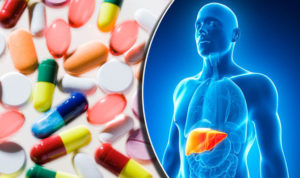Drug-induced liver injury (DILI) accounts for approximately 10% of all cases of acute hepatitis.
How does it happen?

Picture source: Daily Express
The liver functions to help the body break down certain medications, including some that are available over-the-counter. Abnormal ingestion of drugs harmful to the liver (hepatotoxic drugs) can affect the function of a healthy liver. Usually the toxicity occurs after taking the causative agent for several weeks, or from an overdose of the medication. Simultaneous use of multiple drugs may add to the severity of hepatitis.
What kind of drugs are usually implicated?
Anti-tuberculosis drugs (especially isoniazid and rifampicin) as well as herbal medications are the most common culprits in Asian countries like Malaysia. Ahmad Marzuki Omar, et al. reported a high prevalence of drug-induced hepatitis (9.7%) in his study. Other studies have shown that >70% of DILI in Singapore and Korea were attributed to herbs or dietary supplements (Wai 2007, Suk 2012).
In the Western world, paracetamol/acetaminophen is the commonest drug responsible for liver inflammation. It can damage the liver when taken in doses higher than what is recommended. However, the severity of intrinsic hepatotoxicity of paracetamol is attenuated in the East, with virtually no cases of liver failure or death reported.
Other drugs that can lead to liver damage include:
- Amiodarone
- Non-steroidal anti-inflammatory drugs (NSAIDs), such as ibuprofen and naproxen
- Amoxicillin, or Co-Amoxiclav
- Oral contraceptive pills
- Erythromycin
- Halothane (a type of anaesthesia)
- Methyldopa
- Isoniazid
- Methotrexate
- Statins (uncommon, in less than 5% of cases)
How do I know if I may have DILI?
Risk factors predisposing to DILI include ethnicity, older age, females, alcohol co-ingestion, pre-existing liver disease, and genetic factors.
When drugs injure the liver and disrupt its normal function, symptoms, signs, and abnormal blood tests suggestive of liver disease develop.
Each individual may experience different symptoms, for example:
- Fever
- Nausea
- Vomiting
- Jaundice – yellowing of the skin and eyes
- Rash or itchy red hives on skin
- Sore muscles
- Flu-like symptoms
- Reduced appetite
What can doctors do about DILI?
Without a doubt, medical history is the most important step in managing DILI; obtaining a history of every drug ingested in the past 3-6 months is essential! This is followed by a focused but thorough physical examination.
Other diagnostic procedures for DILI include the following:
- Liver function tests
- Full blood counts
- Coagulation profiles
- Electrolyte tests
- Tests for other chemicals in the body
- Drug screening tests
- Ultrasound of the hepatobiliary system
- Viral hepatitis, autoimmune hepatitis workup to rule out other possibilities.
- Liver biopsy may be considered if the hepatitis is persistent or worsening despite stopping the causative drugs.
How is DILI managed?
DILI typically presents in one of three clinical patterns:
- Hepatitis: Elevated AST/ALT (two-fold rise)
- Cholestasis: elevated alkaline phosphatase (two-fold rise)
- Mixed picture with damage to both biliary canaliculi and hepatocytes: Variable elevations in aminotransferases (two-fold rise) and alkaline phosphatase (two-fold rise)
Liver failure is a possible complication but uncommon initial presentation of DILI.
Early diagnosis and withdrawal of the suspected medication is the mainstay of treatment of DILI. Monitoring liver enzymes – alanine aminotransferase (ALT) and aspartate aminotransferase (AST) – is essential while withdrawing the causative drug. Usually, most cases of drug-induced hepatitis go away within days or weeks after stopping the offending drug.
N-acetylcysteine (NAC), a precursor of glutathione, is used in the treatment of paracetamol hepatotoxicity. It should be started in suspected paracetamol-induced DILI, especially if there is an elevation in AST, a detectable serum acetaminophen level, or if the level is above the treatment line on the Rumack-Matthew normogram.
Unfortunately, other than NAC, there are no specific antidotes for drug-induced liver disease. Ursodeoxycholic acid is an option in managing drug-induced cholestasis, while cholestyramine may be used to alleviate pruritus.
Patients presenting with fever, rash and eosinophilia should be considered for a diagnosis of drug-induced autoimmune hepatitis. If the DILI is severe, corticosteroid therapy is warranted as it is almost invariably effective.
Fulminant hepatic failure from drug-induced hepatotoxicity – defined as the presence of hepatic encephalopathy within eight weeks of the development of symptoms due to the causative drug – may require liver transplantation. The King’s College criteria is used in order to determine when a patient requires liver transplantation.
If you have acute hepatitis, you should avoid physical exertion, alcohol, paracetamol and any other hepatotoxic substances.
Conclusion
DILI is a condition that could easily be avoided. It is important to never use more than the recommended dose of over-the-counter medicines containing acetaminophen. If you drink alcohol heavily or regularly, you should avoid these medications and talk to your doctor about safe doses. If you have liver disease, please tell your doctor about all the medicines you take. Avoid all possible hepatotoxic medications as much as possible and discuss with your doctor which ones are safe for you.
References
Christin Giordano, John Rivas,and Xaralambos Zervos. An Update on Treatment of Drug-Induced Liver Injury. J Clin Transl Hepatol. 2014 Jun; 2(2): 74–79.
By Dr Chieng Jin Yu, Medical Lecturer, Consultant Gastroenterologist and Hepatologist, Universiti Putra Malaysia (UPM).
[This article belongs to The Malaysian Medical Gazette. Any republication (online or offline) without written permission from The Malaysian Medical Gazette is prohibited.]
